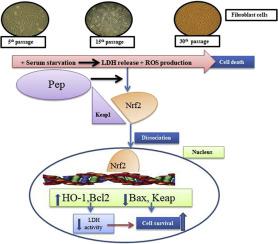Food Bioscience ( IF 5.2 ) Pub Date : 2020-03-08 , DOI: 10.1016/j.fbio.2020.100566 Naveen Kumar , Savita Devi , Sanusi Bello Mada , Srinu Reddi , Rajeev Kapila , Suman Kapila

|
Starvation conditions cause cell injury or ulcers from reactive oxygen species generation and, ultimately, lead to cell death or apoptosis. Milk has many bioactive peptides with cytoprotective potential. One such peptide is the buffalo milk β-casein derived antioxidative peptide, VLPVPQK. It was found to have cytoprotective action during oxidative stress. However, the protective role of the peptide in natural aging induced apoptosis has not been studied. In the present study, the anti-apoptotic effect of the peptide was analyzed by establishing an in vitro model of skin fibroblast cells with serum starved conditions similar to aging. Cell survivability and cytotoxicity were measured using MTT and LDH assays, respectively. Cell death rate was determined using propidium iodide staining. In addition, gene level expression of anti-apoptotic markers’ such as Nrf2, Keap-1, Bcl-2, Bax and HO-1 were analyzed using quantitative real time-PCR. While nuclear transmigration of Nrf2 at the protein level was analyzed using western blots. The peptide treatment led to inhibition of cell death as observed using PI, DCFH-DA staining and improvement in cell survival through the activation of transcription factor, Nrf2. The activation of Nrf2 stimulated the expression of cytoprotective signals from HO-1. Moreover, the peptide augmented the cellular protection by inhibiting the expression of the Nrf2 inhibitor (Keap1), pro-apoptotic markers (Bax) and stimulating anti-apoptotic (Bcl-2) gene expression. In addition, a pronounced reduction in the activity of the cell injury marker, LDH was observed. Hence, this study showed that the antioxidative peptide, VLPVPQK also showed an anti-apoptotic effect.
中文翻译:

通过指导Nrf2调节饥饿的成纤维细胞中水牛酪蛋白来源的生物活性肽的抗凋亡作用
饥饿条件导致细胞损伤或活性氧物种产生的溃疡,并最终导致细胞死亡或凋亡。牛奶具有许多具有细胞保护潜力的生物活性肽。一种这样的肽是水牛乳β-酪蛋白衍生的抗氧化肽,VLPVPQK。发现它在氧化应激中具有细胞保护作用。然而,尚未研究该肽在自然衰老诱导的细胞凋亡中的保护作用。在本研究中,通过建立体外分析了该肽的抗凋亡作用血清饥饿状态类似于衰老的皮肤成纤维细胞模型。分别使用MTT和LDH测定法测量细胞存活率和细胞毒性。使用碘化丙啶染色确定细胞死亡率。另外,使用定量实时PCR分析了抗凋亡标记物如Nrf2,Keap-1,Bcl-2,Bax和HO-1的基因水平表达。使用蛋白质印迹分析了Nrf2在蛋白质水平上的核转运。使用PI,DCFH-DA染色观察到,肽处理可导致细胞死亡抑制,并通过激活转录因子Nrf2改善细胞存活率。Nrf2的激活刺激了来自HO-1的细胞保护信号的表达。此外,该肽通过抑制Nrf2抑制剂(Keap1)的表达增强了细胞保护作用,促凋亡标记(Bax)和刺激性抗凋亡(Bcl-2)基因表达。另外,观察到细胞损伤标记物LDH的活性明显降低。因此,这项研究表明抗氧化肽VLPVPQK也显示出抗凋亡作用。


























 京公网安备 11010802027423号
京公网安备 11010802027423号